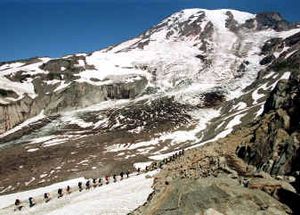Rainier’s Carbon River Road to become trail for hikers, bikers
NATIONAL PARKS -- Mount Rainier National Park officials have given approval to convert Mount Rainier’s Carbon River Road into a 9-mile trail for hiking and biking.
The road has been closed to vehicles since it was heavily damaged in a 2006 storm. It leads to the Ipsut Creek campground, which now is only reachable by hikers or bikers.
The park service Friday also decided to convert the campground to backcountry use, according to a Tacoma News-Tribune story. When money becomes available, a new vehicle campground is planned elsewhere in the park.
Since the road was built in the 1920s, rocks and gravel from floods have raised the bed of the Carbon River by up to 31 feet, with some stretches of the road now lower than the river.
The conversion will cost $3.2 million and will begin this summer with the installation of log jams to protect the trail, the News-Tribune reports. Rebuilding the road would have cost as much as $11.4 million.
The road, which provided the only vehicle access to Ipsut Creek Campground and several trailheads, has not been open to vehicle traffic since the 2006 flood. The road has remained open for bikers and hikers.
Dave Uberuaga, park superintendent, had called the proposal the toughest decision of his eight-year tenure as the park’s leader. However, in mid-January, he’d come to peace with the choice, though he knew it would upset some people.
“It sounds trite, but I had to go through a grieving process,” Uberuaga said. “The loss, accepting it, then moving and making the most of it.”
The day he submitted the proposal, he biked up the road in the rain to the campground and then hiked toward the Carbon Glacier before heavy snow turned him back.
“The light went on,” Uberuaga said. “It was really fun. … It’s a new visitor experience. And once visitors get used to it as a bike ride, they’ll find a day trip to the glacier is doable for a lot of people.”
With the road closed, the hike to the snout of the glacier that once was seven-mile round trip now covers 16.8 miles. The hike once was one of the most popular day hikes in the park and its loss seemed toughest for those opposed to closing the road.
“A lot of elderly people with grandkids and people with disabilities can’t do it and come away disappointed,” said David Wolf, who says he hikes in the area almost every weekend. “You can tell by the looks on their faces. It’s a real shame.”
John Wilcox of Graham said he understands why the park chose to convert the road but dislikes the decision.
“They are fighting mother nature and they have a responsibility to spend money correctly,” Wilcox said. “But I feel that maybe they are going beyond what they need to do.”
Wilcox, who worked at Rainier for 28 years, including a stint as the Carbon River District ranger, hoped the park would reopen 3.6 miles of the road. The proposal would have cost $10.8 million.
“As you hike the Carbon River Road you can go year after year without another major flood,” Wilcox said. “During that lull you can’t help but ask why the road wasn’t repaired, even temporarily.”
Uberuaga says future floods are inevitable. The road has been washed out numerous times since it was built in 1925, including twice during the four years of construction.
Less than $1 million will be spent on the conversion this year, Uberuaga said. Bike racks will be installed at trail heads and the campgrounds so cyclists no longer have to stash their bikes in the bushes or chain them to trees.
The most significant work planned for the summer will be installing log jams to protect the trail and the park entrance.
Eventually, a turnout will be installed 1.2 miles up the road for vehicles to drop off cyclists.
Uberuaga said the park also is talking to the Mountaineers about using some of the group’s property outside the park for parking.
Ipsut Creek Campground will remain for backcountry campers.
“In the end, I feel a lot better about this,” Uberuaga said. “I think it will be a great family friendly place to stay overnight or take a day trip.”

